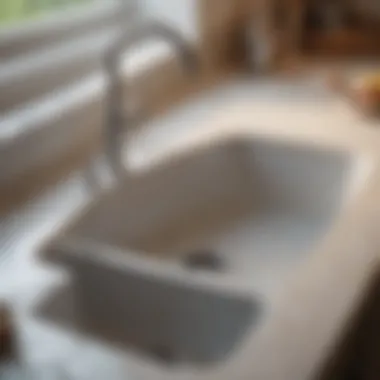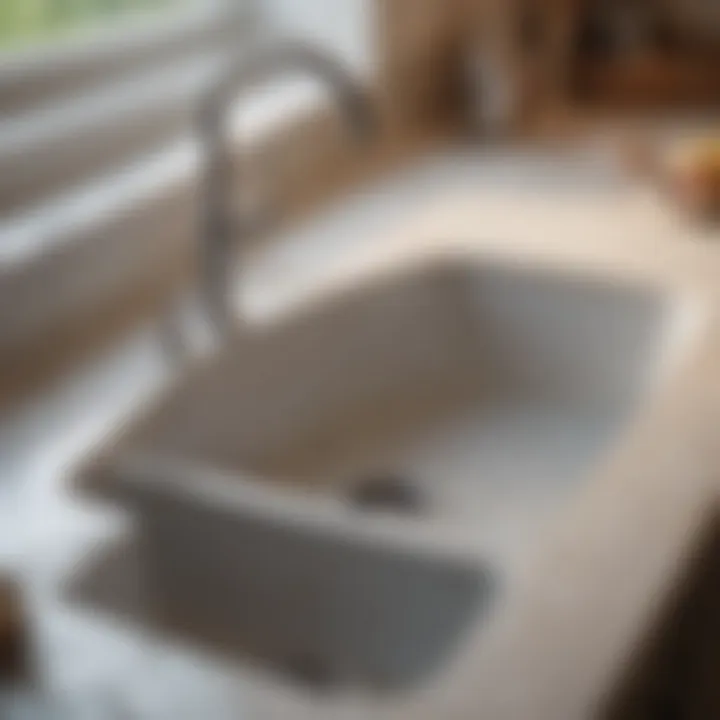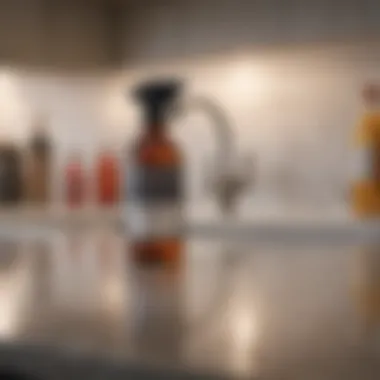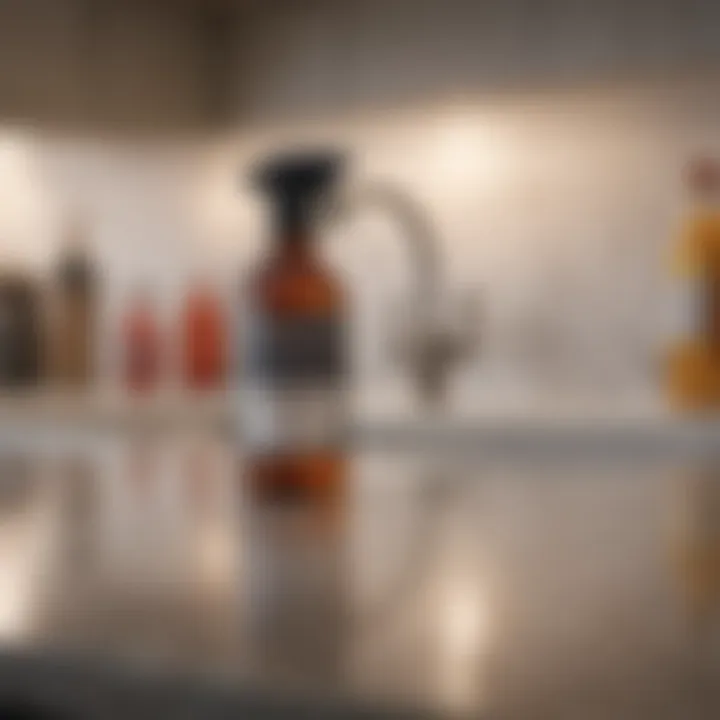Unclog Your Drain: Effective Methods Without a Plunger


Intro
Unclogging a drain can often feel like an uphill battle, especially when the usual tools, like a plunger, are not an option. Homeowners and renters alike understand that slow or blocked drains can be a significant nuisance. It affects the functionality of a home, leading to potential water damage and inconvenience. Fortunately, there are several effective methods to address this situation without the typical reliance on a plunger. This narrative will explore practical solutions that can be employed using readily available materials and techniques.
In this guide, we aim to shed light on various strategies for unclogging drains. From simple household remedies to chemical solutions, each method is carefully considered to ensure efficiency and safety. We will provide clear and concise instructions, alongside preventative measures that can help maintain clear drain systems in the long run. This comprehensive approach will serve to empower individuals in tackling their plumbing challenges with confidence unless one gets comfortable and starts neglecting regular maintenance tasks.
Prologue to Drain Clogs
Clogs in drains are a nuisance that arises frequently in many households. Understanding the nature and causes of these clogs can help homeowners take proactive steps to prevent them from becoming serious issues. This section aims to lay a foundation for broader strategies used in unclogging drains. Knowing how clogs occur gives insight into the methods you can use to tackle them effectively.
Understanding Drain Clogs
Drains carry away wastewater, so when they become clogged, it disrupts this essential function. A clog occurs when materials accumulate and obstruct the flow of water. Often, these materials are organic matter, grease, soap, or hair. Each type of drain—from sinks to toilets—has its specific considerations.
It's important to recognize that not all clogs are created equal. Some may be near the surface and easier to remedy, while others can be deep within plumbing systems. Addressing these issues promptly is essential to maintain a functional plumbing system. The longer a clog persists, the more complicated and potentially costly it can become to resolve.
Common Causes of Clogs
Identifying common causes of drain clogs provides valuable insight that helps in both prevention and resolution. Here is a breakdown of frequent contributors:
- Hair: Often trapped in bathroom sinks and shower drains, hair mixes with soap residue, forming substantial blockages.
- Grease: In kitchen sinks, grease from cooking is a common culprit. It solidifies in pipes, causing significant obstructions.
- Soap: Traditional soaps can leave behind residue that accumulates over time, leading to clogs.
- Food Particles: Inadequate disposal of food wastes can cause clogs in kitchen drains.
- Foreign Objects: Items such as toys or paper towels can accidentally fall into drains, leading to severe blockages.
"Addressing clogs proactively can save time and avoid more significant plumbing issues later on."
Recognizing these causes allows individuals to employ preventative measures. Moreover, knowing the typical offenders provides a clearer view of which techniques might be suitable for unclogging a drain without a plunger.
Common Household Tools and Items
The section on common household tools and items is crucial for understanding how everyday materials can effectively unclog drains without resorting to a plunger. Utilizing items readily found in most homes not only fosters creativity but also promotes eco-friendly solutions to plumbing issues. These methods tend to be cost-effective and minimize the necessity for chemical drain cleaners, which can harm both plumbing and local waterways.
When faced with a clog, the first step often involves evaluating the tools you have at your disposal. A closer look at basic items such as baking soda, vinegar, salt, and dish soap reveals their potential in clearing drains. These tools are not just easily accessible; their combined properties can create effective chemical reactions or physical impacts that help break down obstructions. The use of these common tools speaks to a practical approach towards home maintenance.
Baking Soda and Vinegar Approach
The baking soda and vinegar method is one of the simplest yet effective ways to tackle clogs. This combination leverages the scientific reaction between an alkaline substance (baking soda) and an acid (vinegar) to produce carbon dioxide, which can help dislodge debris. To employ this technique, follow these steps:
- First, ensure that your drain is as clear of standing water as possible.
- Then, pour a half cup of baking soda directly into the drain.
- Next, follow it with a half cup of vinegar.
- You may hear fizzing sounds which indicate the reaction is occurring.
- Finally, let this mixture sit for about 30 minutes before flushing the drain with hot water.
This method is not only effective but also environmentally friendly, making it a preferred choice for many homeowners who wish to avoid harsh chemicals.
Salt and Hot Water Method
The salt and hot water method employs two simple materials to create a potent solution for stubborn clogs, particularly those caused by grease. Salt acts as an abrasive agent, and when combined with hot water, it helps in breaking down the blockage. Here’s how to use this method:
- Start by boiling a kettle of water.
- Once boiled, pour about a half cup of salt down the drain.
- Immediately follow with the hot water.
- Let it work for about 10 to 15 minutes before running more hot water through.
It’s essential to note that using this method regularly can aid in preventing clogs from forming in the first place. Regular maintenance using salt and hot water is a small yet impactful step towards ensuring a free-flowing drain.


Dish Soap and Boiling Water Technique
Using dish soap in tandem with boiling water is another practical solution for greasy clogs commonly found in kitchen sinks. The dish soap helps to break down the grease, creating a smoother flow through the drain. Here’s the step-by-step guide:
- Start by pouring a generous amount of dish soap directly into the clogged drain.
- Following that, carefully pour boiling water down the drain.
- Allow this mixture to sit for several minutes, letting the soap penetrate any grease buildup.
- Finally, run warm water down to flush away any remaining debris.
This method is particularly effective due to the nature of dish soap, which is formulated to break down grease. Regular application can serve as a preventative measure against disruptions in flow.
Using household items like baking soda, vinegar, salt, and dish soap allows individuals to address common drain issues with confidence and sustainability.
In summary, these common household tools and items are not just cost-saving alternatives; they reflect an entirely different approach to handling plumbing issues. By incorporating these techniques, one can maintain clear drains without the need for a plunger, making home maintenance both practical and effective.
Chemical Solutions for Unclogging Drains
Chemical drain cleaners provide an alternative when conventional tools fail. These solutions are designed to break down clogs, making them useful for various types of blockages. They can dissolve obstructions in an efficient manner, often much faster than mechanical methods. When faced with persistent issues in the drainage system, it is important to consider the role of chemical solutions and the specific elements that make them beneficial. However, there are also essential considerations to keep in mind to ensure safe and effective use.
Understanding Drain Cleaners
Drain cleaners typically come in liquid form, although some may also be found in powder or crystal format. Their main purpose is to eliminate build-up caused by hair, grease, soap residue, and other materials that can cause clogs. The composition of these cleaners includes strong chemicals like sodium hydroxide or sulfuric acid, which serve to break down organic matter.
Understanding how these substances interact with blockages can lead to better outcomes while using them. For example, sodium hydroxide generates heat, which helps to melt some types of clogs, while sulfuric acid is powerful enough to clear more severe blockages. Their effectiveness can often outperform natural remedies, making them a go-to solution for serious drain issues.
Types of Chemical Drain Cleaners
There are various types of chemical drain cleaners available on the market, each designed for particular kinds of clogs.
- Caustic Cleaners: These are alkaline-based and work by creating heat and gas to break down materials.
- Acidic Cleaners: Containing strong acids, these solutions can dissolve tough clogs but may also corrode pipes if not used correctly.
- Enzymatic Cleaners: These use natural enzymes to eat away at organic matter and are typically less harmful to plumbing systems. They may take longer to work but are more environmentally friendly.
Choosing the right type based on the nature of the clog is essential for an effective unclogging strategy.
Cautions When Using Chemicals
While chemical drain cleaners can be helpful, they come with their own risks.
- Safety Precautions: Always wear gloves and goggles to protect skin and eyes. The chemicals can cause severe burns.
- Ventilation: Ensure the area is well-ventilated when using these products to avoid inhaling fumes.
- Compatibility with Plumbing: It's crucial to assess whether a particular cleaner is safe to use with your type of pipes. Some materials can corrode with certain chemicals.
- Environmental Impact: Many chemical cleaners can negatively affect local ecosystems, so consider eco-friendly alternatives when possible.
*Using chemical solutions for unclogging should always be followed with careful consideration of safety and environmental effects.*
By understanding these key elements related to chemical drain cleaners, homeowners can make informed decisions regarding their use. Effective unclogging often requires a blend of techniques and a thorough approach to maintain a fully functional drainage system.
Mechanical Methods for Clogs
Mechanical methods offer practical and efficient solutions to unclog drains without relying on chemical agents or plungers. These techniques are especially useful for those who prefer straightforward, hands-on approaches to deal with drain blockages. Each method has its unique advantages, particularly in their ability to physically remove the obstruction, ensuring that the drain flows freely once more. Understanding and applying these methods can save time and prevent complications associated with persistent clogs.
Using a Drain Snake
A drain snake, often referred to as a plumber's snake, is an excellent tool for dealing with stubborn clogs within pipes. Its design includes a long, flexible metal cable that can navigate the twists and turns of plumbing systems. This tool effectively breaks apart or retrieves blockages that are otherwise unreachable.


To use a drain snake, follow these steps:
- Insert: Carefully insert the snake into the drain opening until you feel resistance.
- Rotate: Turn the handle while gently pushing forward to navigate the snake deeper into the pipe.
- Hook: If you feel the device snag something, slowly pull it back out. This can help remove hair, grease, or other debris that may be causing the clog.
It is important to note that using a drain snake can require a bit of strength and patience, especially when dealing with particularly tough blockages. However, the effectiveness of this tool can often resolve issues that chemicals cannot.
Employing a Wire Hanger
A wire hanger can be an effective alternative for minor clogs. Although it may seem unconventional, a simple household item can be transformed into a drain-clearing tool.
To use it:
- Unwind the hanger: Straighten out the wire, leaving a small hook at one end.
- Insert: Gently push the hooked end into the drain.
- Catch: Try to catch and pull out any blockage you encounter.
This method works well for smaller clogs, particularly those caused by hair or small food particles. Its benefits lie in its accessibility; most people have a wire hanger at home. Yet, it’s important not to force it too much, as excessive manipulation could damage the pipes.
Wet/Dry Vacuum Technique
Using a wet/dry vacuum is another highly effective mechanical method for unclogging drains. This approach is particularly beneficial for dealing with liquid clogs or substantial debris.
To employ this method:
- Set the Vacuum: Ensure your vacuum is set to the liquid setting.
- Seal the Area: Use duct tape or a rag around the drain opening to create a seal, which will enhance the vacuum’s efficiency.
- Suction: Turn on the vacuum and let it run for several minutes.
The vacuum will create a strong suction that can lift liquids as well as some solid blockages. Yet, caution is advised - always ensure that the vacuum can handle liquids and follow the manufacturer's guidelines.
By understanding these methods, homeowners are better equipped to maintain their plumbing accordingly. Each technique has its merits, making them worthy of consideration for anyone looking to unclog a drain without a plunger.
Preventative Measures to Avoid Clogs
Preventing drain clogs is more effective and less stressful than dealing with them once they occur. Implementing certain preventative measures can save time, money, and reduce the hassle associated with clogged drains. Understanding how everyday habits affect drainage systems helps individuals maintain their plumbing effectively.
Regular Drain Maintenance
Regular maintenance of drains is crucial. Keeping a schedule for checking and cleaning drains can prevent potential blockages. Simple actions can go a long way:
- Cleaning traps and strainers: These are usually found in bathroom sinks or kitchen sinks. Regularly removing and cleaning these parts eliminates debris and materials that could cause build-ups.
- Flush with hot water: Pouring hot water down the drain weekly helps break down grease and soap residues. This is particularly effective in kitchen sinks where greasy substances accumulate.
- Using natural cleaners: As an alternative to harsh chemicals, using baking soda followed by vinegar can help clear minor buildup. This method is safe for pipes and environmentally friendly.
By performing these tasks routinely, one can avoid many common drain issues.
Proper Waste Disposal Practices
Handling waste disposal properly is important for drain health. Certain items should never be sent down the drain:
- Avoid pouring grease or oil: These substances can solidify and cause blockages.
- Limit disposal of fibrous foods: Items like celery, potato peels, and pasta can create clogs.
- Use a composting method for organic waste: Instead of putting food scraps down the disposal, composting is a better option. It reduces strain on plumbing systems.
Educating household members about proper waste disposal increases awareness and enhances drain health.


Using Drain Covers and Filters
Utilizing physical barriers such as drain covers and filters can decrease the amount of debris entering the drain. These tools are effective in a variety of locations:
- Kitchen sinks: Installing a mesh strainer captures food particles before they enter the plumbing.
- Bathtubs and shower drains: Drain covers prevent hair and soap residue from clogging the pipes. Regular cleaning of these covers ensures they function effectively.
- Outdoor drains: For homes with patios or pools, using grates can stop leaves and debris from blocking outdoor drains.
With minimal cost and effort, these measures can significantly extend the functionality of drainage systems.
Remember: A little effort in maintenance can prevent significant future expenditures in plumbing repairs. Regular upkeep and awareness of proper disposal can lead to a more efficient and stress-free household plumbing system.
When to Call a Professional
Knowing when to seek professional help with a clogged drain can save time, resources, and potential damage to your plumbing system. While many minor clogs can be handled with at-home techniques, some issues require the expertise of a plumber. This helps ensure the problem is resolved correctly and efficiently.
It is essential to identify signs that indicate a serious clog. Ignoring these signs can lead to worsening problems and, ultimately, more expensive repairs. Additionally, understanding the costs associated with professional help can also facilitate informed decisions for homeowners.
Signs of a Serious Clog
There are several indicators suggesting that a clog is more severe than it appears:
- Frequent Drain Issues: If multiple drains in your home are slow or backing up, this may suggest a main sewer line issue, which requires immediate professional attention.
- Unpleasant Odors: Foul smells coming from the drains may indicate trapped debris or even stagnant water caused by a block in the sewage system.
- Gurgling Sounds: Unusual noises such as gurgling can often signal air trapped in the plumbing system due to a blockage.
- Visible Water Damage: If you noticed water pooling around the drain or on the floor, it can suggest a more significant plumbing issue.
If any of these signs appear, contacting a professional plumber is advisable. They have the proper tools and expertise to address complicated clogs effectively.
Costs Associated with Professional Help
Hiring a plumber comes with costs that can vary depending on a few factors. It is beneficial to understand these costs before deciding to call a professional:
- Service Fees: Most plumbing services charge an initial fee for dispatch. This can range based on the plumber’s location and experience.
- Hourly Rate: The hourly rates for plumbers can vary widely. Expect rates to range from $45 to $200, depending on factors such as complexity of the issue and geographic area.
- Parts and Materials: In some cases, you might need replacement parts. These costs can significantly add up, particularly if extensive repairs are required.
- Emergency Services: If you encounter a plumbing emergency outside of regular business hours, additional fees will apply.
While the expense may seem high, addressing serious plumbing issues promptly can prevent extensive damage and save money in the long run.
"Acting fast helps protect your home and its value."
Understanding these costs can help you prepare. Evaluating the severity of your clog is crucial so that you can decide wisely when to seek help.
End
Recap of Unclogging Techniques
Multiple techniques are laid out across this article. Here are key methods:
- Baking Soda and Vinegar Approach
This classic method leverages a chemical reaction to break down clogs. - Salt and Hot Water Method
Salt can assist in absorbing waste, while hot water helps dissolve it further. - Dish Soap and Boiling Water Technique
A combination that aids in lubricating pipes, making it easier for clogs to slide away. - Using a Drain Snake
A mechanical aspect that manually clears blockages with a flexible tool. - Employing a Wire Hanger
A creative use for a common household item can help in dislodging minor clogs. - Wet/Dry Vacuum Technique
This powerful tool can effectively suction stubborn clogs out of the drain.
Each of these methods offers unique advantages. Depending on the severity and nature of the clog, one can select the most appropriate technique.
Final Thoughts on Maintenance
Preventive measures are essential in maintaining clear drains. Regular upkeep plays a critical role in minimizing the chances of future clogs. It is advised to perform basic maintenance checks periodically. Simple practices like using drain covers can catch debris before it accumulates. Additionally, being mindful of waste disposal habits can greatly reduce the risk of blockages.
Taking a proactive approach in managing your home plumbing not only saves time but also reduces long-term costs.
By adopting these methods and insights from this article, homeowners can ensure their plumbing systems remain in good condition. Taking care of one's drains is not merely reactive; it is a fundamental aspect of general home care.







